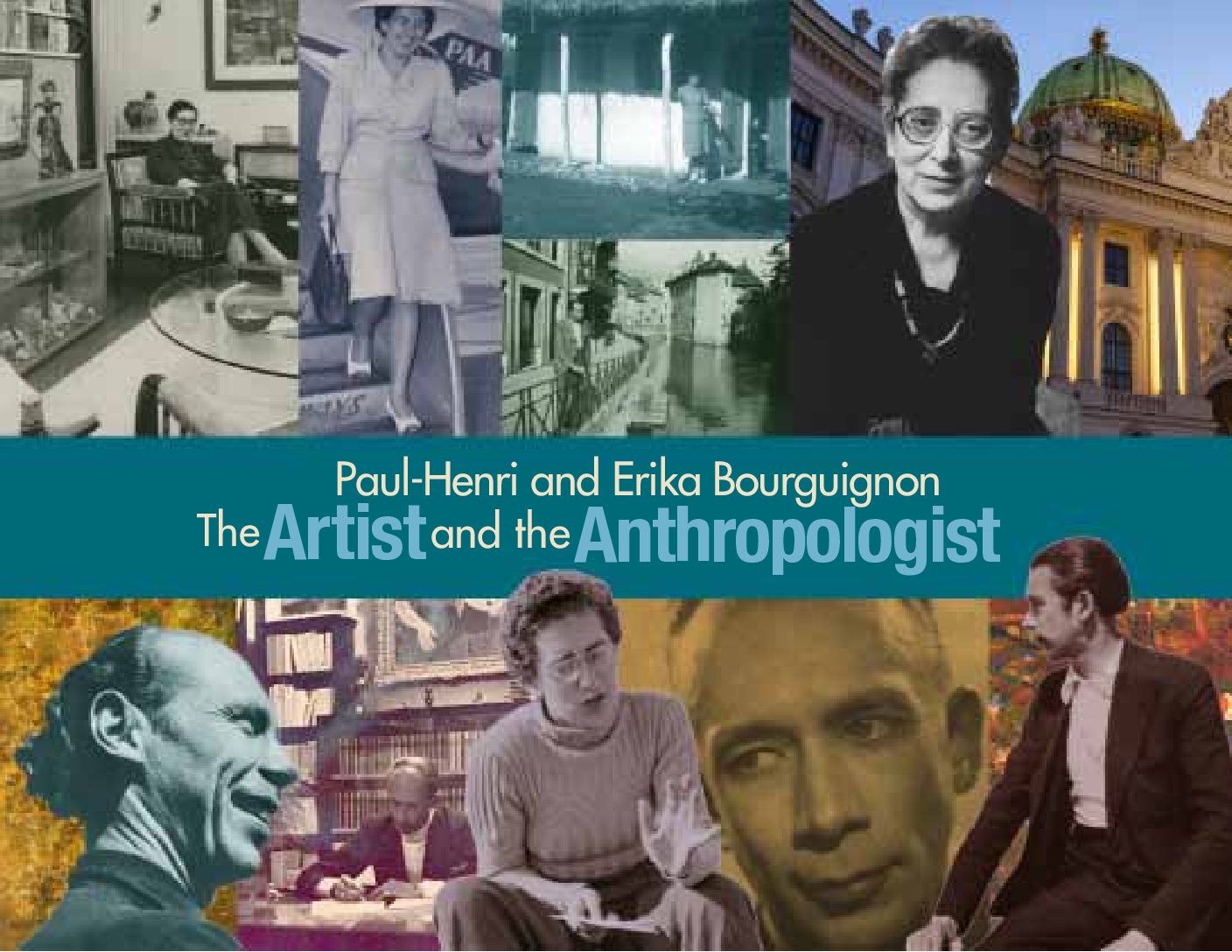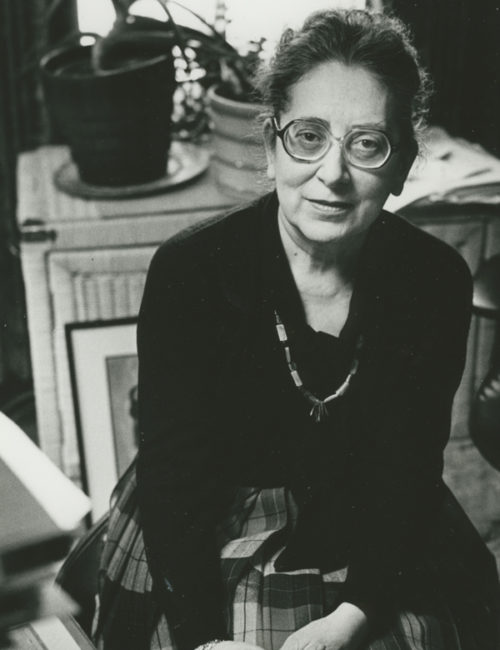Paul-Henri Bourguignon
Talented visual artist, prolific writer, journalist, skillful photographer, and an avid observer of the human condition, Paul-Henri Bourguignon left a lasting legacy of artwork.
Artwork
Bourguignon’s paintings incorporate a multitude of significant modernist art movements. As art critic in Brussels in the 1940s, he personally knew and wrote about many of the great artists of the time. After he moved to Columbus and began painting full time, he experimented with these movements and techniques for decades. Learn more about his work below.
“The light of Paris, the exoticism of Spain, North Africa, and Yugoslavia, all aroused the painter’s curiosity, his senses, and his keen capacity for observation. Memories of these regions, reworked and transmuted, recurred in his paintings for the rest of his life.”
Excerpt from exhibition catalog, 1996
“Far from being realist portraits, [Bourguignon’s faces] are reductive forms, often imbued with a patchwork of layered textures and colors and with simply rendered lines of brushwork to indicate, with the barest possible detail… In Bourguignon’s portraits, what reads as primitivism may instead be simply a kind of pure expression that naturally lends itself to his unsentimental and uncomplicated vision. The colors of the faces themselves recall the intensity of Fauvist imagery.”
Michael Abatemarco,
“Faces in the Crowd: Paul Henri Bourguignon”
Pasatiempo, arts publication
of the Santa Fe New Mexican,
February 14, 2014
VIEW FACES
“Sometimes forms (usually figurative) push their way to our eyes as if carved out from the dense ground. Other times a thin line of white describes a surface pattern that just might resolve into a suggestive image. In these works the observation/stylization balance reverses, but the artist’s means are just as economical. He reveals enough clues for our observing eyes to recognize a stylized shape as a profile or a figure in motion.”
Ann Bremner,
Exhibition publication,
Paul-Henri Bourguignon: A Retrospective,
Schumacher Gallery, Capital University,
Columbus, Ohio, 1989
VIEW FIGURES
“The absorption and permeability of his painting contain diverse histories and cultures and urge us to break down such abstract distinctions as developed/underdeveloped, civilized/primitive, historic/ prehistoric, all of which oversimplify the nature of the encounter between the West and the rest of the world.”
Joan Dayan
“The Craft of Memory: Bourguignon’s Haitian Paintings”
in Paul-Henri Bourguignon: The Haitian Works,
Gallery V exhibition publication, 1996
VIEW ARTWORK INSPIRED BY HAITI
“The paintings create seemingly vast and deep expanses, punctuated by surface accents of linear and textural patterning. At once intimate and monumental, [these compositions] often relinquish all descriptive associations. To Bourguignon, however, the paintings never became fully abstract; he preferred to see them as filled with multivalent references, there waiting to be found.”
Exhibition publication,
Paul-Henri Bourguignon: A Retrospective,
Schumacher Gallery, Capital University,
VIEW ABSTRACTS
“In the 1980s, Paul began carving unique and whimsical heads and figures from solid backgrounds [later, labeled “Wonderheads”]. Similar to Michaelangelo, Paul had a piece of stone and brought out what was inside.”
—Erika Bourguignon
VIEW WONDERHEADS
“The paintings create seemingly vast and deep expanses, punctuated by surface accents of linear and textural patterning. At once intimate and monumental, [these compositions] often relinquish all descriptive associations. To Bourguignon, however, the paintings never became fully abstract; he preferred to see them as filled with multivalent references, there waiting to be found.”
Exhibition publication,
Paul-Henri Bourguignon: A Retrospective,
Schumacher Gallery, Capital University,
VIEW DRAWINGS
Bourguignon’s artwork can be found in public and private collections in more than three dozen states in the U.S. and two dozen countries throughout the world.
VIEW ARTWORK IN COLLECTIONS

FEATURED EVENTS
The Painter’s Eye:
Paul-Henri Bourguignon’s Faces and Figures
Opening Reception at Art Access Gallery l February 7, 2025 | 5:00–7:00 P.M.
540 South Drexel Avenue l Columbus OH 43209
This special exhibition celebrates Bourguignon’s figurative work. Far from being realist portraits, his faces and figures are reductive forms, often a patchwork of layered textures and colors with simply rendered lines of brushwork to indicate distinguishing characteristics with the barest possible detail. These paintings and drawings have never been exhibited before at Art Access Gallery.
Art Access Gallery hours: Wed–Fri 11 am–5 pm, Sat 11 am–4 pm l 614-338-8325

Media
Explore a documentary, videos, and the house tour of a groundbreaking couple from Columbus, Ohio. Paul, a talented visual artist, was an observer of the human condition throughout his life. His paintings are in museums and collections around the world. Erika was an Anthropology professor and, later, the department chair at The Ohio State University. She was considered to be the foremost anthropological authority on trance, possession and altered states of consciousness.

1924-2015
Erika Bourguignon
Erika Eichhorn Bourguignon (1924–2015) was an American anthropologist. Considered to be the foremost anthropological authority on trance, possession, and altered states of consciousness, she was well known for her contributions to psychological anthropology, anthropology of religion, and the anthropology of women.
Born in Vienna in 1924, Bourguignon emigrated to the United States with her parents, Luitpold and Charlotte (Rosenbaum) Eichhorn, in 1939 after after the 1938 Anschluss. She earned a B.A. from Queens College (1945), and a Ph.D. from Northwestern University (1951). Her field studies included work with the Chippewa Indians in Wisconsin and in Haiti where she met her husband, Belgian writer and artist Paul-Henri Bourguignon (1947–48).
Arriving at The Ohio State University in 1949, Bourguignon became a founding member of what would become the Department of Anthropology. She taught the first course on anthropology of women at the university, chaired a newly formed Council on Academic Excellence for Women, and was the first woman to chair a department in OSU’s College of Social and Behavioral Sciences. She taught for more than 40 years. She directed a groundbreaking five-year project, a Cross-Cultural Study of Dissociational States, with a grant from the National Institute of Mental Health. She published seven books and more than eighty professional articles. Her honors include Ohio State’s Alumni Distinguished Scholar Award (1986), the Society for Psychological Anthropology’s first Lifetime Achievement Award (1999), and a Doctor of Humane Letters degree (2000) from Queens College.